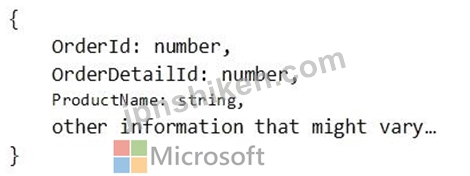有効的なDP-200J問題集はJPNTest.com提供され、DP-200J試験に合格することに役に立ちます!JPNTest.comは今最新DP-200J試験問題集を提供します。JPNTest.com DP-200J試験問題集はもう更新されました。ここでDP-200J問題集のテストエンジンを手に入れます。
DP-200J問題集最新版のアクセス
「242問、30% ディスカウント、特別な割引コード:JPNshiken」
注:この質問は、同じシナリオを提示する一連の質問の一部です。 シリーズの各質問には、記載された目標を達成する可能性のある独自のソリューションが含まれています。 一部の質問セットには複数の正しい解決策があり、他の質問セットには正しい解決策がない場合があります。
このシナリオで質問に回答すると、その質問に戻ることはできません。 その結果、これらの質問はレビュー画面に表示されません。
Azure Cosmos DBデータベースにSalesという名前のコンテナーがあります。 Salesには120 GBのデータがあります。 Salesの各エントリには、次の構造があります。

パーティションキーはOrderId属性に設定されます。
ユーザーは、ProductNameでデータを取得するクエリを実行すると、クエリの完了に予想よりも長い時間がかかると報告しています。
問題のあるクエリの実行にかかる時間を短縮する必要があります。
解決策:データベースの要求単位(RU)を増やします。
これは目標を達成していますか?
このシナリオで質問に回答すると、その質問に戻ることはできません。 その結果、これらの質問はレビュー画面に表示されません。
Azure Cosmos DBデータベースにSalesという名前のコンテナーがあります。 Salesには120 GBのデータがあります。 Salesの各エントリには、次の構造があります。

パーティションキーはOrderId属性に設定されます。
ユーザーは、ProductNameでデータを取得するクエリを実行すると、クエリの完了に予想よりも長い時間がかかると報告しています。
問題のあるクエリの実行にかかる時間を短縮する必要があります。
解決策:データベースの要求単位(RU)を増やします。
これは目標を達成していますか?

